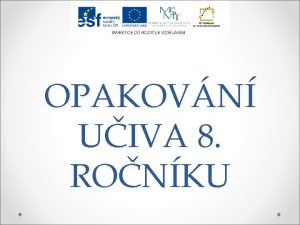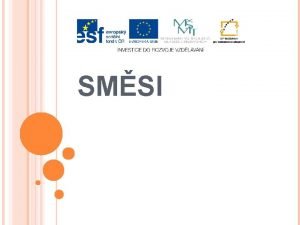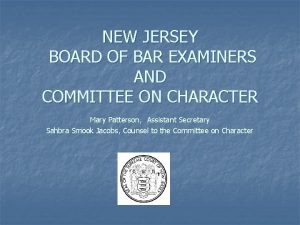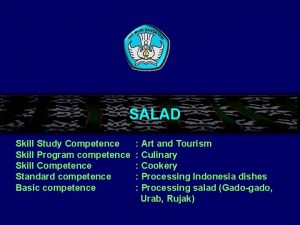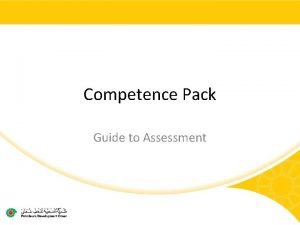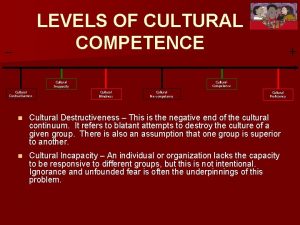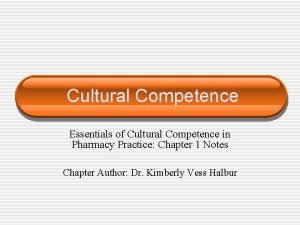Summary of study results New Competence for SMEs


















- Slides: 18

Summary of study results New Competence for SMEs. Do SMEs know how to benefit from foreign students?

Contents Introduction The report in a nutshell. Slide 3 International talents in SMEs Background data on participating SMEs. Slides 4 -5 Results Answers to the questions of why, how, what benefits, and what challenges? Slides 7 -13 Messages to institutions Development proposals from companies to educational institutions Slides 14 -18

Introduction • Why the New Competence -project? CIMO wished to investigate • • if SMEs utilise the competence of foreign HE and VET trainees as well as foreign students graduating from Finnish higher education institutions? • the benefits and challenges encountered by companies and solutions found to the challenges. • SMEs create jobs, and internationalisation is a key pathway to growth. The project was underpinned by the assumption that international talents are an underused resource. • The objective is to lower the threshold for SMEs to host international talents. • Data collection in spring and autumn 2016: • An electronic survey among SMEs and company interviews were used as key material. A literature review of previous studies and reports was also carried out. • Other data and materials • The website www. uuttaosaamista. fi contains a more extensive version of the publication (in Finnish), videos describing companies’ experiences as well as a set of slides for educational institutions, stakeholders and companies on the possibilities of benefitting from international talents (in Finnish and in English). 3

International talents in SMEs? • A total of 386 SMEs responded to the survey conducted as part of the study. • 32% of the respondents had hosted international talents: 64% had hosted foreign higher education students, 43% foreign VET students, and 7% both. • In most cases, the companies had hosted two students. Two larger companies had received up to 200 students. • The most common period in which companies had hosted students was 2014 -2016 (77%). 4 4

Compared to SMEs that had not hosted international talents, SMEs that had hosted them: • Contain a higher share of growthoriented and international companies. • In almost all of the companies, English is one of the working languages. • Also include a slightly higher share of older companies. • Companies of all sizes have hosted students. The greatest numbers of students had been working in companies with 5 -49 employees. • Almost all sectors were represented. Mostly, the students had been working in the service, industrial, information and communication, and hotel and catering sector as well as in wholesale and retail companies. 5

Companies with international talents: Results: Why had the company hosted international talents? 6

Companies with international talents: Results: How did the company find the international talent? 7

Companies with international talents: Results: Benefits brought to companies by international talents by level of education 8

Companies with international talents: Results: Companies’ motives for hosting international talents: On the basis of data on the companies’ motives for hosting international talents, different profiles were modelled. These motives partly overlap. • ”Aiming abroad” companies wanted to draw on the students’ skills to support their internationalisation. • ”Talent hunters” often already are international companies, and the talent's background thus makes no difference. What matters is their competence and potential. • ”Internationalisation at home” companies had hosted an international talent as an extra pair of hands, or maybe to strengthen their competence in serving foreign customers. • ”Corporate social responsibility” companies hosted international talents when requested to do so as an additional resource or to improve the employees’ linguistic and cultural skills. 9

Companies with international talents: Results: Benefits brought by international talents to companies examined by the company's motive: 10

Companies with international talents: Results: Challenges experienced by companies Average 1 (none) – 4 (very many) • The most common challenges encountered by companies that hosted foreign VET students for work placement were inadequate resources for guiding the student and the lack of a common language. • For companies that hosted higher education students, inadequate resources for guiding the student and challenges arising from differences in working cultures were somewhat more common. 11

Companies with no international talents Results: Companies with no international talents • • Companies could need the additional resources and special competence brought by an international talent in the future. About one out of four believed that they could use international talents to support their internationalisation. The most common reason for the companies not hosting international talents was that the companies and the students had failed to meet, or the company had no need for trainees in general. 12 12

All companies Results: What type of support is required from educational institutions? • Companies would like more information about the possibilities of hosting and benefitting from international talents • Among companies that have hosted international talents, the ones that had hosted higher education students, in particular, appeared to have less need for support. • Companies that have hosted foreign VET students have received more support from educational institutions. 13

Key messages to educational institutions Information about possibilities • • Communicate about how international talents’ competence can be utilised. Market the benefits and make them visible. Better matches in recruitment • Matching international talents with companies is based on knowing the persons. How can you facilitate this? Business cooperation Operate as bridge-builders, listening to the companies: company visits, invitations, fairs, recruitment meetings - there are many ways of doing this. Companies are different, which should be taken into account in the cooperation. • Developing guidance and instruction • • Career guidance and linguistic studies should have closer links with everyday life. The students should have more capabilities for making their competence visible.

Information about possibilities • A relatively large share of companies do not know enough about the possibilities of hosting and benefitting from international talents. Some of the SMEs that have hosted students also find that the cooperation is sporadic. Clear communication about foreign students and the possibilities is needed. While entrepreneurs appreciate being contacted directly by the students, awareness of recruiting international talents should be raised among both entrepreneurs and students. Questions to consider: • In what forums and on what media do you communicate about utilising foreign students for the companies’ needs? How accessible is this information? • Companies need different talents for different needs: do you target your information and offer services responding to those different needs? Do you work together with other education providers in the area, for example in the sphere of information activities? • Do you utilise regional partners and networks? Do you work together with regional entrepreneurs’ organisations, business companies or the Chamber of Commerce? Do you cooperate with other education providers in the area, for example when approaching stakeholders?

Business cooperation and business life development • In business cooperation and RDI, internationalisation should be a competitive advantage that can be supported by matching international talents with companies. Practices of working life cooperation should be harmonised and designed to respond to company needs. There are plenty of methods for business cooperation, and companies should thus be listened to when using them. Questions to consider: • Are your practices of working life cooperation harmonised and clear? Are they also implemented at the level of teachers? Have they been communicated to companies and stakeholders? • Do clear practical opportunities and forms exist for the working life cooperation? • Are alumni used in business and stakeholder cooperation? • Have the needs and possibilities of hosting foreign students been identified in regional development plans? Have they links to regional business development? How is this seen in practice? • Does the training of workplace supervisors in VET include the guidance of foreign students in work placement?

Better matches in recruitment • Companies would like students and employers to be brought together; this should also be taken into consideration in recruitment services and working life cooperation. If necessary, vocational institutions and HEIs should analyse the tasks together with the employer and provide support for the company. Questions to consider: • How do your practices of recruitment and working life cooperation help to bring international talents and companies together? Do you have systematic methods and opportunities for company visits, fairs, projects, recruitment meetings or other practices of communicating information from companies to students and vice versa? Has information about these been disseminated. Have they been productised? • How is information about the talents communicated between international coordinators, working life cooperation and RDI actors as well as teachers? • Is the information communicated about the student and his or her competence sufficient? Is the student able to identify the special competence he or she has to offer for the company (and the competence he or she will gain through the work experience)? • Are companies provided with sufficient support? Have the rules and responsibilities been specified together?

Developing guidance and instruction • Mastery of the working life language and professional vocabulary is appreciated, and it should be highlighted, especially in language studies for degree students. This would also require additional focus on supervising traineeships on the part of the higher education institution. Providing students with working life skills and capabilities is also important when aiming for the Finnish labour market. Questions to consider: • Does your educational offering contain sufficient instruction in the Finnish language foreigners? Has its content been examined from the perspective of working life needs? Have learning the language and Finnish working life practices been included in the objectives of the student’s traineeship? • Do the studies prepare the student sufficiently for the Finnish working life and work culture? E. g. plain speaking and bringing up issues are appreciated by companies. • How can the student build capabilities for marketing his or her competence? How is this supported?
 Různorodá směs navzájem rozptýlených kapalin
Různorodá směs navzájem rozptýlených kapalin Polymerbeton směs
Polymerbeton směs Green action plan for smes
Green action plan for smes Různorodá směs nerostů
Různorodá směs nerostů Heterogenní směs
Heterogenní směs Frf for smes vs gaap
Frf for smes vs gaap New jersey bar application
New jersey bar application Fspos
Fspos Novell typiska drag
Novell typiska drag Nationell inriktning för artificiell intelligens
Nationell inriktning för artificiell intelligens Vad står k.r.å.k.a.n för
Vad står k.r.å.k.a.n för Shingelfrisyren
Shingelfrisyren En lathund för arbete med kontinuitetshantering
En lathund för arbete med kontinuitetshantering Adressändring ideell förening
Adressändring ideell förening Tidböcker
Tidböcker Sura för anatom
Sura för anatom Vad är densitet
Vad är densitet Datorkunskap för nybörjare
Datorkunskap för nybörjare Stig kerman
Stig kerman
